Ventilation outlet for metal tiles - purpose and
Such roofing materials as a professional flooring and a metal tile recently enjoy wide popularity that is connected with their durability, reliability and a number of other advantages. However, the metal roof has one major drawback - it does not allow air. To provide air exchange in the under-roof space, a ventilation outlet for a metal tile is installed on the roof - a structure resembling a small chimney.
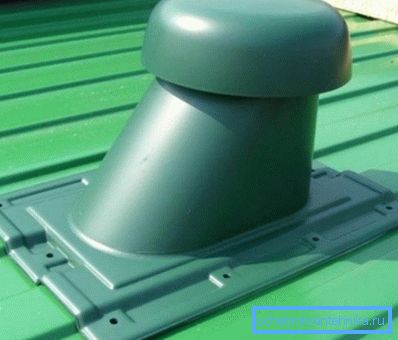
Next, we take a closer look at what the function of these products and the features of their installation.
Why do you need ventilation of roof space
Ventilation of the roof of metal is needed primarily to ensure productive and durable operation of all elements of the roof structure.
If you neglect the ventilation or perform it is not high quality, it can lead to the following negative consequences:
- The accumulation of condensate, resulting in moisture accumulates on the wooden parts of the structure, which causes them to rot. In addition, condensation leads to corrosion of the metallic coating, especially in areas where the protective coating is damaged.
- The formation of moisture on the surface of the roof - as a result of which frost is formed and the material is gradually destroyed.
- Namokaniyu insulation, as a result, heating costs increase.
Thus, the ventilation outlets for metal tiles are a prerequisite for the durability of the roof.

Features of roof ventilation
Ventilation of the roof of metal can be implemented in two ways:
- Dotted - air escapes through spot ventilation aerators.
- Continuous - the extract is realized through the continuous ventilated ridge for a metal tile.
Regardless of the method of ventilation, air circulation is as follows:
- The air penetrates through the eaves in the roof space.
- Then passes over the entire roof area.
- After that comes out with steam and heat.
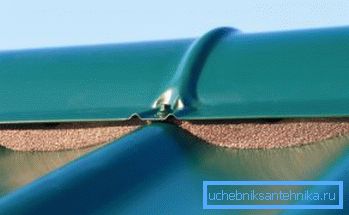
I must say that often the owners are afraid that precipitation will penetrate through the ventilation pipes to the attic. However, these fears are in vain, since the design of aerators prevents this possibility.
The advantage of point outputs is that they can be installed after the installation of the roof, while the ventilated ridge is installed during the construction of the roof.
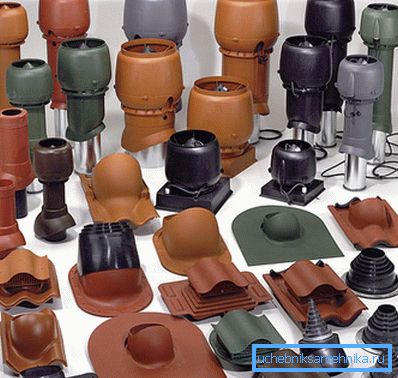
Output device
Outputs are a construction that consists of three main elements:
| Ventilation pipe | The main part, which provides the output of air flow from the roofing space to the outside |
| Of passage | The mounting element of the structure, which provides a tight joint between the pipe and the roof covering. |
| Deflector (umbrella) | Prevents precipitation from entering the pipe. |
Note! In order for the ventilation passage through the metal tile to be airtight, the passage element must repeat the roofing profile. Therefore, the profile must pay attention when choosing a product.
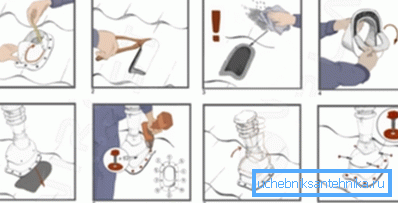
Mounting outputs
Location
To ensure that ventilation for metal tiles is as efficient as possible, before installing ventilation elements, it is necessary to determine their number and location. If the roof has an area not exceeding 60 square meters or a simple construction, for example, of a gable or hip shape, then one pipe can be used.
If the roof has a complex shape with several edges, then the aerator should be located at each edge.
The exact position of the device determines the architect or the owner of the house, however, there are several rules that must be followed:
- From the ridge to the pipe there should be a distance of no more than 0.6 meters.
- The larger the roof area, the more such devices need to be installed.
- On one sheet of metal can be installed no more than one aerator.
Having defined the location of the outlets and their number, you can proceed to installation.
Installation design
The installation instructions for the outputs are quite simple:
- First of all, a template should be attached to the location of the future structure (usually available in the kit to the product) and circle it with a marker.
- Then, along the designated line, drill holes as close as possible to each other.
- After that, you need to cut your own hole with scissors for metal or a hacksaw.
- Then a silicone sealant is applied around the perimeter of the hole and a passage element is installed. The quality of the passage of the ventilation pipe through the metal tile will determine the tightness of the roof and, as a result, its durability. Therefore, the installation must be carried out strictly according to the instructions from the manufacturer.
- Next, you should coat the place of passage of the pipe with a sealant and put on the sealing ring.
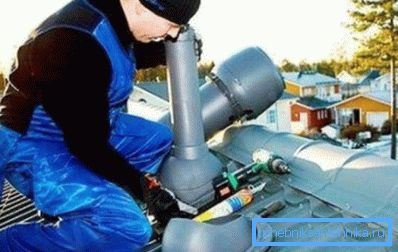
- Then the pipe itself is installed. Before fixing the structure with screws, you need to check the vertical with a building level.
Tip! In order for the design to look harmoniously on the roof, its color must match the color of the metal tile or be combined with it.
This process is complete. Of course, you can entrust the work of specialists, however, the price of their services can be quite high. Therefore, it is much more profitable to do it yourself, moreover, it does not take much time.
Conclusion
Ventilation outlets are a necessary element of the metal roof, on which its durability depends. If during the construction of the house or the replacement of the roof the builders made a mistake and did not provide ventilation of the roofing space, then the installation of aerators can be done independently.
The main thing is to correctly determine their number and location so that the air exchange is effective.
From the video in this article you can learn more about this topic.